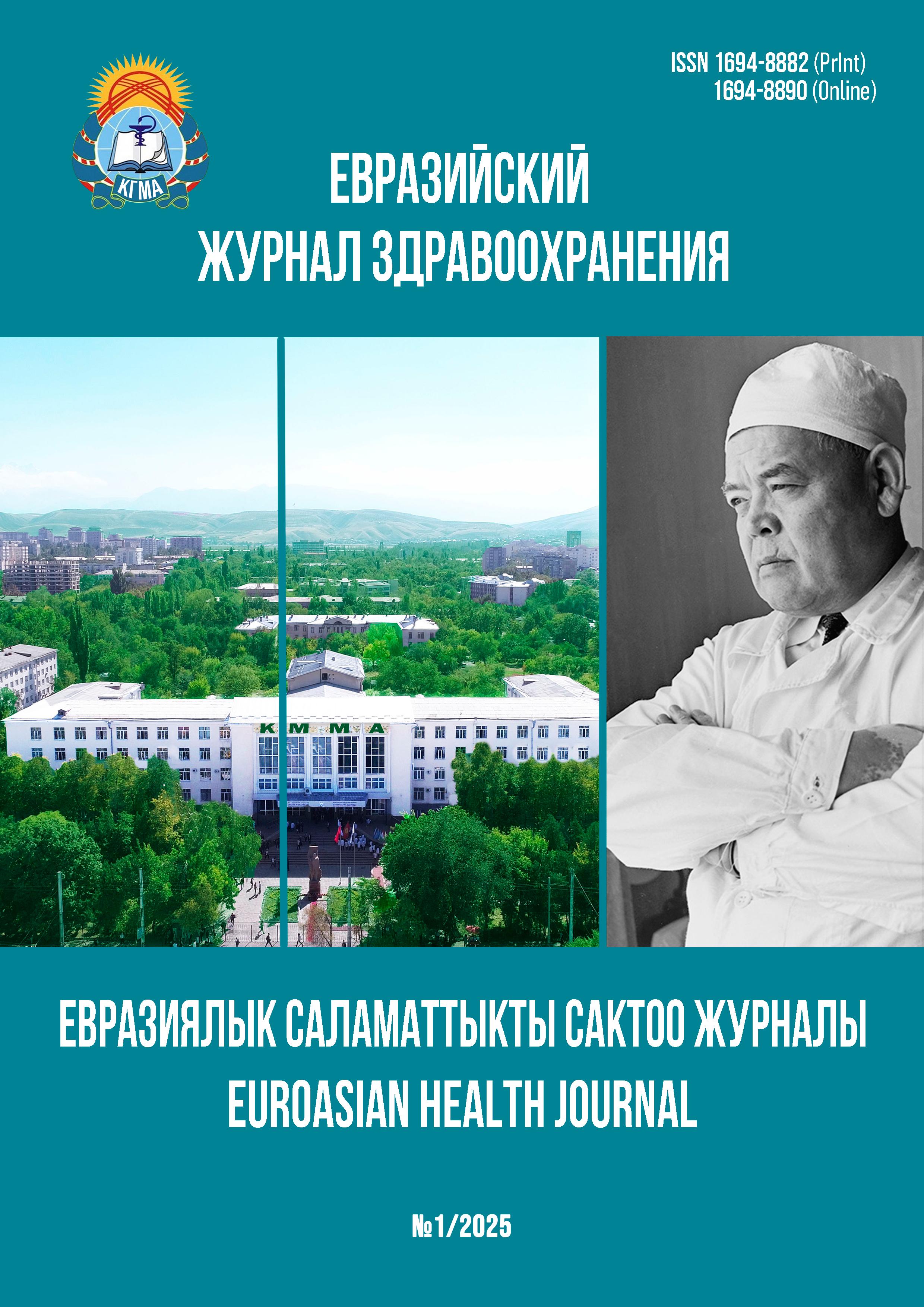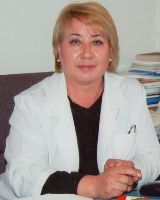ВОЗРАСТНЫЕ И ГЕНДЕРНЫЕ РАЗЛИЧИЯ ПОКАЗАТЕЛЕЙ ЖЕСТКОСТИ АРТЕРИЙ И ПАРАМЕТРОВ ОТРАЖЕННОЙ ВОЛНЫ
DOI:
https://doi.org/10.54890/1694-8882-2025-1-84Аннотация
Повышение артериальной жесткости и параметров отраженной волны, является независимым фактором риска не только сердечно-сосудистых заболеваний, но и прогрессирования повреждения органов. Одними из источников, объясняющих индивидуальные различия в жесткости артерий, являются возрастные изменения и половая принадлежность исследуемых. Увеличение жесткости артерий является основной причиной повышения систолического и пульсового артериального давления, а также снижения диастолического артериального давления в процессе старения. Большая артериальная жесткость у женщин с сопутствующими сердечно-сосудистыми заболеваниями сохраняется даже после поправки на возраст, индекс массы тела, среднее артериальное давление и частоту сердечных сокращений. Учитывая, что половые различия играют важную роль в физиологии сердечно-сосудистой системы, включение жесткости артерий в качестве дополнительной переменной при диагностике может служить биомаркером для мониторинга здоровья кардиоваскулярной системы. В обзорной статье представлены данные научных исследований, посвященных изучению возрастных и половых различий артериальной ригидности сосудов и параметров отраженной волны.
Ключевые слова:
жесткость артерий, индекс отраженной волны, возраст, старение, пол.Библиографические ссылки
1. GBD 2016 Mortality Collaborators. Global, regional, and national under-5 mortality, adult mortality, age-specific mortality, and life expectancy, 1970-2016: a systematic analysis for the Global Burden of Disease Study 2016. Lancet. 2017;390(10100):1084-1150. https://doi.org/10.1016/S0140-6736(17)31833-0
2. Piepoli M, Hoes A, Agewall S, Albus C, Brotons C, Catapano AL, et al. 2016 European Guidelines on cardiovascular disease prevention in clinical practice: The Sixth Joint Task Force of the European Society of Cardiology and Other Societies on Cardiovascular Disease Prevention in Clinical Practice (constituted by representatives of 10 societies and by invited experts) Developed with the special contribution of the European Association for Cardiovascular Prevention & Rehabilitation (EACPR). Eur Heart J. 2016;37(29):2315-2381. https://doi.org/10.1093/eurheartj/ehw106
3. Lusis AJ. Atherosclerosis. Nature. 2000;407(6801):233-241. https://doi.org/10.1038/35025203
4. Oliveira AC, Cunha PMGM, Vitorino PVO, Souza ALL, Deus GD, Feitosa A, et al. Vascular Aging and Arterial Stiffness. Arq Bras Cardiol. 2022;119(4):604-615. English, Portuguese. https://doi.org/10.36660/abc.20210708
5. Franklin SS, Jacobs MJ, Wong ND, L'Italien GJ, Lapuerta P. Predominance of isolated systolic hypertension among middle-aged and elderly US hypertensives: analysis based on National Health and Nutrition Examination Survey (NHANES) III. Hypertension. 2001;37(3):869-874. https://doi.org/10.1161/01.hyp.37.3.869
6. World Health Organization. Global Action Plan for The Prevention and Control of Noncommunicable Diseases 2013–2020. Geneva: [Accessed November 14, 2013]. Available from: https://www.who.int/publications/i/item/9789241506236
7. Centers for Disease Prevention and Control. Data and Statistics on Congenital Heart Defects. 2019; Available from: www.cdc.gov/ncbddd/heartdefects/ data.html
8. Tucker T. Physics Linkages Between Arterial Morphology, Pulse Wave Reflection and Peripheral Flow. Artery Res. 2023;29:46–71. https://doi.org/10.1007/s44200-023-00033-5
9. O'Rourke M, Hashimoto J. Mechanical factors in arterial aging: a clinical perspective. J Am Coll Cardiol. 2007;50(1):1-13. https://doi.org/10.1016/j.jacc. 2006.12.050
10. Izzo JL Jr. Brachial vs. central systolic pressure and pulse wave transmission indicators: a critical analysis. Am J Hypertens. 2014;27(12):1433-1442. https://doi.org/10.1093/ajh/hpu135
11. Chae CU, Pfeffer MA, Glynn RJ, Mitchell GF, Taylor JO, Hennekens CH. Increased Pulse Pressure and Risk of Heart Failure in the Elderly. JAMA. 1999;281(7):634–643. https://doi.org/10.1001/jama.281.7.634
12. Цой Л.Г., Сабиров И.С., Полупанов А.Г. Состояние эндотелиальной функции у больных ишемической болезнью сердца пожилого возраста, осложненной хронической сердечной недостаточностью в процессе лечения бета-блокатором бисопрололом. Вестник КРСУ. 2021;21(1):93-97.
13. Franklin SS, Pio JR, Wong ND, Larson MG, Leip EP, Vasan RS, et al. Predictors of new-onset diastolic and systolic hypertension: the Framingham Heart Study. Circulation. 2005;111(9):1121-7. https://doi.org/10.1161/01.CIR.0000157159. 39889.EC
14. Torjesen AA, Wang N, Larson M, Hamburg NM, Vita JA, Levy D, et al. Forward and backward wave morphology and central pressure augmentation in men and women in the Framingham Heart Study. Hypertension. 2014;64(2):259-65. https://doi.org/10.1161/HYPERTENSIONAHA.114.03371
15. O'Rourke M, Nichols W. Aortic diameter, aortic stiffness, and wave reflection increase with age and isolated systolic hypertension. Hypertension. 2005;45 (4):652-8. https://doi.org/10.1161/01.HYP.0000153793.84859.b8
16. Westerhof BE, Westerhof N. Magnitude and return time of the reflected wave: the effects of large artery stiffness and aortic geometry. J Hypertens. 2012;30(5):932-939. https://doi.org/10.1097/HJH.0b013e3283524932
17. Sharman J, Davies J, Jenkins C, Marwick T. Augmentation index, left ventricular contractility, and wave reflection. Hypertension. 2009;54(5):1099-105. https://doi.org/10.1161/HYPERTENSIONAHA.109.133066
18. World Health Organization. Life Expectancy at Birth (Years). Available from: https://www.who.int/data/gho/data/indicators/indicator-details/GHO/life-expectancy-at-birth-(years)
19. Wilkinson AL, Fleming PJ, Halpern CT, Herring AH, Harris KM. Adherence to gender-typical behavior and high frequency substance use from adolescence into young adulthood. Psychol Men Masc. 2018;19(1):145-155. https://doi.org/10.1037/men0000088
20. Nakagawa S, Hart C. Where’s the beef? How masculinity exacerbates gender disparities in health behaviors. Socius. 2019;5:237802311983180. https://doi.org/10.1177/2378023119831801
21. Mesler RM, Leary RB, Montford WJ. The impact of masculinity stress on preferences and willingness-to-pay for red meat. Appetite. 2022;171:105729. https://doi.org/10.1016/j.appet.2021.105729
22. European Commission: Directorate-General for Health and Consumers. The State of Men’s Health in Europe. Publications Office; 2011. Available from: https://data.europa.eu/doi/10.2772/60721 (Accessed February 23, 2024).
23. Feraldi A, Zarulli V. Patterns in age and cause of death contribution to the sex gap in life expectancy: a comparison among ten countries. Genus. 2022;78(1):23. https://doi.org/10.1186/s41118-022-00171-9
24. Prentice D, Carranza E. What women and men should be, shouldn’t be, are allowed to be, and don’t have to be: the contents of prescriptive gender stereotypes. Psychol. Women Q. 2002;26:269-281. https://doi.org/10.1111/1471-6402.t01-1-00066
25. Meslé F, Vallin J. Historical trends in mortality. In: Rogers R, Crimmins E, eds. International handbook of adult mortality. Vol 2. Springer: Dordrecht; 2011:9-47. https://doi.org/10.1007/978-90-481-9996-9_2
26. Концевая А.В., Мырзаматова А.О., Халматов А.Н., Худяков М.Б., Полупанов А.Г., Алтымышева А.Т. и др. Результаты 4-летнего проспективного наблюдения в исследовании Интерэпид: факторы, влияющие на заболеваемость и смертность популяции в сельских регионах России и Кыргызской Республики. Кардиоваскулярная терапия и профилактика. 2018;17(2):49–56. https://doi.org/10.15829/1728-8800-2018-2-49-56
27. Becker RC, Gore JM, Lambrew C, Weaver WD, Rubison RM, French WJ, et al. A composite view of cardiac rupture in the United States National Registry of Myocardial Infarction. J Am Coll Cardiol. 1996;27(6):1321-1326. https://doi.org/10.1016/0735-1097(96)00008-3
28. Marlatt KL, Kelly AS, Steinberger J, Dengel DR. The influence of gender on carotid artery compliance and distensibility in children and adults. J Clin Ultrasound. 2013;41(6):340-346. https://doi.org/10.1002/jcu.22015
29. Russo C, Jin Z, Palmieri V, Homma S, Rundek T, Elkind MS, et al. Arterial stiffness and wave reflection: sex differences and relationship with left ventricular diastolic function. Hypertension. 2012;60(2):362-368. https://doi.org/10.1161/ HYPERTENSIONAHA.112.191148
30. Coutinho T, Bailey KR, Turner ST, Kullo IJ. Arterial stiffness is associated with increase in blood pressure over time in treated hypertensives. J Am Soc Hypertens. 2014;8(6):414-421. https://doi.org/10.1016/j.jash.2014.03.330
31. Wilkinson IB, MacCallum H, Flint L, Cockcroft JR, Newby DE, Webb DJ. The influence of heart rate on augmentation index and central arterial pressure in humans. J Physiol. 2000;525(Pt 1):263-270. https://doi.org/10.1111/j.1469-7793.2000.t01-1-00263.x
32. Gatzka CD, Kingwell BA, Cameron JD, Berry KL, Liang YL, Dewar EM, et al. Gender differences in the timing of arterial wave reflection beyond differences in body height. J Hypertens. 2001;19(12):2197-2203. https://doi.org/ 10.1097/00004872-200112000-00013
33. Costa-Hong VA, Muela HCS, Macedo TA, SalesARK, Bortolotto LA. Gender differences of aortic wave reflection and influence of menopause on central blood pressure in patients with arterial hypertension. BMC Cardiovasc Disord. 2018;18(1):123. https://doi.org/10.1186/s12872-018-0855-8
34. Vlachopoulos C, Aznaouridis K, O'Rourke MF, Safar ME, Baou K, Stefanadis C. Prediction of cardiovascular events and all-cause mortality with central haemodynamics: a systematic review and meta-analysis. Eur Heart J. 2010;31(15):1865-1871. https://doi.org/10.1093/eurheartj/ehq024
35. Davies JI, Struthers AD. Pulse wave analysis and pulse wave velocity: a critical review of their strengths and weaknesses. J Hypertens. 2003;21(3):463-472. https://doi.org/10.1097/00004872-200303000-00004
36. London GM, Guerin AP, Pannier BM, Marchais SJ, Metivier F. Body height as a determinant of carotid pulse contour in humans. J Hypertens Suppl. 1992;10(6):S93-S95. PMID: 1432337.
37. Hayward CS, Kelly RP. Gender-related differences in the central arterial pressure waveform. J Am Coll Cardiol. 1997;30(7):1863-1871. https://doi.org/ 10.1016/s0735-1097(97)00378-1
38. Do KA, Green A, Guthrie JR, Dudley EC, Burger HG, Dennerstein L. Longitudinal study of risk factors for coronary heart disease across the menopausal transition. Am J Epidemiol. 2000;151(6):584-593. https://doi.org/10.1093/ oxfordjournals.aje.a010246
39. Takahashi K, Miura S, Mori-Abe A, Kawagoe J, Takata K, Ohmichi M, et al. Impact of menopause on the augmentation of arterial stiffness with aging. Gynecol Obstet Invest. 2005;60(3):162-166. https://doi.org/10.1159/000086570
40. Polupanov AG, Khalmatov AN, Altymysheva AT, Lunegova OS, Mirrakhimov AE, Sabirov IS, et al. The prevalence of major cardiovascular risk factors in a rural population of the chui region of Kyrgyzstan: the results of an epidemiological study. The Anatolian Journal of Cardiology. 2020;24(3):183-191. https://doi.org/10.14744/AnatolJCardiol.2020.59133
41. Zaydun G, Tomiyama H, Hashimoto H, Arai T, Koji Y, Yambe M, et al. Menopause is an independent factor augmenting the age-related increase in arterial stiffness in the early postmenopausal phase. Atherosclerosis. 2006;184(1):137-142. https://doi.org/10.1016/j.atherosclerosis.2005.03.043







